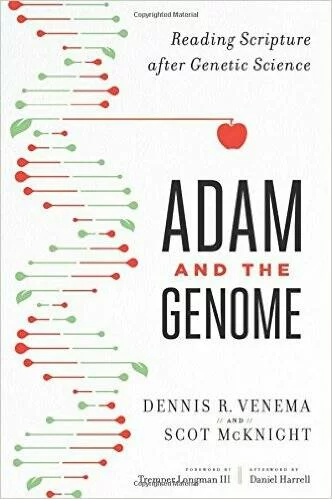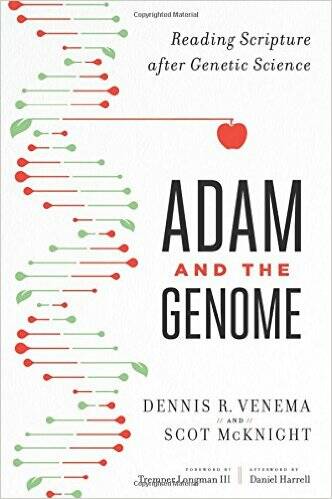Becoming reasonably conversant with contemporary developments and bringing biblical teaching to bear on commonplace assumptions is a perennial challenge for thoughtful Christians.
One of the more pressing questions the church now confronts is a perceived conflict between the findings of the Human Genome Project and the Christian tradition regarding the common origin of humanity in a singular historical pair, Adam and Eve. Dennis Venema and Scot McKnight’s new book, Adam and the Genome, is a provocative interdisciplinary effort by two evangelicals—one a biologist, the other a New Testament scholar—proposing acceptance of the HGP claims and loosening the tie between the idea of a “historical Adam and Eve” and the presumed clear teaching of Scripture.
Much can be said about this book. Being neither a scientist nor an exegete, I’d like to focus my reflections on some of the broader contours of the argument, specifically the way the two parts of the book hold together, and some of the unexpected inconsistencies the authors express.
Genetics Research and Scripture: Weighing Claims, Evidence, and Conclusions
In the first half of the book, Venema provides an overview of data leading to the current consensus view in evolutionary biology. His presentation is fascinating, detailed, and blessedly lucid for non-specialists. The bottom-line regarding human origins is this: “the population genetics data … indicate we descend from a population of about 10,000 individuals” (44).
McKnight’s section proceeds on this assumption. What are we to make of the claim that we descend from a population of approximately 10,000 individuals, and that there were pre-Adamite humans? “What about those two humans in Genesis 1-3? And what about the eight that survived Noah’s flood?” McKnight asks. “Which are we to believe, the Bible or science?” (93). We can set aside for the moment McKnight’s belief in the Bible. As for his belief in science, that is clear enough: “[I]f the Human Genome Project has any weight in our worldview, to insist that our DNA comes from two humans, Adam and Eve, is intentionally to run contrary to what science now teaches with considerable evidence” (145).
While such claims recur throughout the book, on closer inspection, Venema makes several important qualifications. Take, for example, the following comments:
[W]e cannot be certain that any of these [hominin] species is in fact a direct ancestor of present-day humans. What these species … show us … is the probable path of our actual lineage, since these species are at least close relatives of our ancestral line. … [H]umans are, biologically speaking, not new—we are the modified descendants of similar species that lived in the past (59, emphasis added).
Or, again, Venema writes:
Science can tell us a few things—we descend from a population rather than a pair; our ancestors likely passed through these sorts of forms; and so on—but it is simply unable to weigh in on the historicity of Adam and Eve as individuals. . . . [I]f they were in fact historical, they were not the sole parents of all humanity but part of a larger population. Beyond this, science cannot say (59, emphasis added).
Notably, McKnight claims more: the “What follows in Adam and the Genome, then, is a basic introduction to the science of evolution and genetics and how it impinges on the basic claim of many Christians: that you and I, and the rest of humans for all time come from two solitary individuals, Adam and Eve. Genetics makes that claim impossible–as I understand it.” (xi, emphasis added). Similarly: “What if one concludes with the scientists that … the DNA of humans on earth today could not have derived from two solitary hominins, Adam and Eve in the Garden of Eden?” (147-48, emphasis added).
These strong claims actually contrast with Venema’s own specific statements. He writes,
the baseline expectation should be that if humans are the product of an evolutionary process, we arrived at our current state as a population. Now it is technically possible that a species could be founded by a single ancestral breeding pair, just as it is technically possible that a new language could be founded by two speakers. This is not what one would usually expect, however—in fact, it would be highly unusual (46, emphasis added).
[McKnight’s] strong claims actually contrast with Venema’s own specific statements.Relatedly, an excerpt from a Christianity Today article covering his work reads: “‘Had humanity begun with only two individuals, without millions of years for development, says an ASA paper, it would have required God’s miraculous intervention to increase the genetic diversity to what is observable today’” (44, emphasis added).
Thus, Venema and McKnight draw divergent conclusions about the implications of the present state of scientific knowledge. On one hand, this shows the difficulty of interdisciplinary work in general. On the other, I think the problems, tensions, and mild incongruity in the book also can be traced to a significant issue: their ambiguity and ambivalence regarding concordism. As such, it may also show what can arise in light of the widespread assumption among evangelicals that all we need is biblical exegesis—banish the systematicians to the sidelines!
“Concordism”: A Reassessment
McKnight defines “concordism” as “a way of reading/interpreting Genesis that is in concord with science as we know it now, thereby granting to the Bible knowledge of science transcending its historical context” (215, n. 76, emphasis added). Of course, a harmonizing approach isn’t exclusive to biblicists; it’s also employed by Christian thinkers holding to an evolutionary paradigm. N.T. Wright, for example, proposes that Adam and Eve might have been elected from among the 10,000 hominins, had representative authority as God’s image conferred upon them, and subsequently failed to fulfill that responsibility.
But McKnight will have none of this: “Instead of fighting that concordist approach to the ‘historical Adam (and Eve),’ I prefer to read Genesis in context to see what light it sheds on humans and human history” (145). Or, again, responding to interpreters suggesting that the Flood occurred but not on a global scale, McKnight’s chief objection is that it “permits a concordist reading of Genesis”; while not denying that such views are possible, he is concerned that they are “determined more by concordism than by historical readings of Genesis in context” (215, n. 75).
While I appreciate McKnight’s focus on historical exegesis, this definition construes concordism as essentially anachronistic. But concordist interpretations need not entail ascribing modern scientific knowledge to the premodern human writers; the object of theological understanding is not what the ancients understood, but the matter to which they point with their own cultural resources. The compatibility of biblical teaching with the extratextual referents of which it speaks is possible because Scripture is ultimately divine authorial discourse. While I appreciate McKnight’s focus on historical exegesis, this definition construes concordism as essentially anachronistic.The congruence between the Word and the world to which it points is expressed in the Augustinian axiom: “a good and true Christian should realize that truth belongs to his Lord, wherever it is found, gathering and acknowledging it even in pagan literature” (On Christian Teaching, II.18).
It’s proper to seek concord, I maintain, not in exegesis or biblical theology, but at the level of systematic-theological interpretation. Alvin Plantinga, recipient of this year’s Templeton Prize, exemplifies the best of Christian concordism in his treatment of the Christianity-science relation. He asserts: “There is superficial conflict but deep concord between science and theistic religion, but superficial concord and deep conflict between science and naturalism.”Alvin Plantinga, Where the Conflict Really Lies: Science, Religion, and Naturalism. Oxford University Press, 2011, ix. Contrary to McKnight’s cursory dismissal of concordism, Plantinga incisively demonstrates that special divine action (including miracles) is not incompatible with the so-called laws of nature. We can “think of the laws of nature as describing what happens when the universe is causally closed (when God isn’t acting specially in the world)”Alvin Plantinga, Where the Conflict Really Lies: Science, Religion, and Naturalism. Oxford University Press, 2011, 80. says Plantinga, but such “laws don’t tell us how things always go” in a cosmos open to divine influence from beyond the natural realm.Alvin Plantinga, Where the Conflict Really Lies: Science, Religion, and Naturalism. Oxford University Press, 2011, 90.
My purpose in citing Plantinga here is twofold: (i) he shows why concordism is important and how it’s done well. Additionally, (ii) his account shows that there is a way of theorizing about scientific data that is in “deep conflict” with Christian theism—namely, one that attributes all processes and events to exclusively natural or material means within a cosmos posited as closed (i.e., metaphysical naturalism, not methodological atheism as such).
For Christian theists, then, the regular processes by which the world ordinarily operates do not rule out special divine action. In this way, Venema’s qualified conclusions—e.g., “it is technically possible that a species could be founded by a single ancestral breeding pair,” albeit exceptionally—still leaves room for the constitution of the first male and female divine image-bearing human beings (in part or in whole) as a special divine act. But note again that McKnight’s claims are far stronger: he says that the genetic data “negates” and renders “impossible” the biblical portrayal. Despite his good intentions to make room for young believers who are budding scientists, his statements here are at best incautious, approximating metaphysical naturalism. Now I’m sure this is inadvertent; he believes in the bodily resurrection of Jesus as well as God’s freedom to enact miracles in the world. But since this is the case, why is his position on the historical Adam stated so strongly?
Conclusion: Assessing the Book’s Material Contribution
As a general reader in matters of science, I find Venema’s tutorial very informative and valuable. As a systematic theologian, I conclude that his more measured statements about what is inferable from current biological research effectively admit that in a cosmos not causally closed, special divine acts remain a perpetual possibility. If I correctly understand the entailments of his presentation of genetics research at present, the processes and patterns he sets forth represent not invariable necessities, but statistical probabilities to a very high degree. Hence this data does not—and for a Christian theist,Many of their scientific and exegetical insights are instructive and suggestive, but the lack of a specific concordist proposal is something of a missed opportunity. in principle it cannot—finally exclude the possibility that by a special act, God created two historical individuals as the first divine image-bearing human beings who are the direct biological ancestors of their kind (whatever view one takes of their genetic makeup).
Many will find much to appreciate in McKnight’s interaction with the biblical texts informed by recent work in comparative studies. But relative to the logical and ontological entailments of the canonical presentation of Adam and Eve, I find his account (disjoining the “historical” from “literary,” “genealogical,” and “archetypal” figure) truncated. And because (for the reasons indicated above) I think he overstates the force for the genetic evidence, I don’t find his argument relative to the HGP thesis as persuasive as Daniel Harrell–the author of the afterword–thinks it is (196, 198).
Venema and McKnight implicitly recognize that concordism as I’ve outlined it is valid: why else engage in dialogue about a perceived interdisciplinary conflict? Many of their scientific and exegetical insights are instructive and suggestive (and accessible—no small feat), but the lack of a specific concordist proposal is something of a missed opportunity. Here’s hoping that their work, along with the kinds of questions it has raised, will stimulate others of all persuasions to build on and refine what’s presented in the book, for the sake of greater clarity in our common project: the search for the most plausible view(s) of the biblical Adam consistent with the biological evidence, interpreted within a Christian theistic framework.








Comments
Be the first one to make a comment!